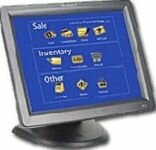
Resistive Touchscreen: Is Resistive The Technology For You And Which Other Touchscreens Should Be Considered?
Resistive touchscreens are growing in popularity due to their durability and high resolution images. This is a relatively new technology which utilizes two flexible sheets that are separated by air gaps and coated by resistive material. Whenever something touches the resistive screen, the two separated sheets come in contact to register the precise location of that touch.
Resistive touchscreens are a type of passive technology because the screen responds to anything that touches it. This is the type of touch screen that you would use with a stylus.
How It Works
A uniform voltage gradient is applied to one sheet. Whenever the second sheet touches the other sheet, the second sheet measures the voltage as a distance along the first sheet. This combination of voltage and distance provide X coordinate.
After the X coordinate is located, the process repeats itself by applying uniform voltage gradient to the second sheet in order to find the Y coordinate. This entire process happens in a matter of milliseconds, oblivious to human eye.
Advantages
 |
A resistive touchscreen is the product of choice for manufacturers because it can easily produce high resolution of 4096 x 4096 DPI or higher. There are several advantages of this technology. Resistive touchscreens are low cost as compared to their ‘active’ counterparts. Prices start at around $130.
This technology can be produced to support multi-touch output. Moreover, a stylus or any pointed object can be utilized to operate such touchscreens.
As its name implies, resistive touchscreens, are widely employed in environments such as hospital laboratories, factories and restaurants because these places contain liquids, chemicals and other contamination that can harm standard screens. A resistive touchscreen is very rugged and robust.
There are also certain disadvantages to these screens such as being sensitive to high pressure and 75% optical transparency. In order to compensate for these deficiencies, developers have created tablets that can differentiate between a stylus and human finger. Advancement in technology has allowed scientists to increase optical transparency.
Comparison
Nevertheless, resistive touchscreen technology has few competitors, if any. Its advantages far outweigh other technologies such as capacitive touchscreens, R.A.W., and Infrared. Interestingly, resistive is the only technology that provides dust resistance.
Furthermore, it can be hermetically sealed and provides immunity from humidity, water droplets, moisture, chemicals, RFI and EMI, among others. A resistive touchscreen can be used with any Federal 508 Appliance and has tactile sense; a quality which is absent in other such technologies. Unlike most screens, it is suitable for Desktop LCD, Open Frame LCD, Chassis LCD and numerous monitor types.
Watch this short video. You will be amazed at how rugged the resistive touchscreen technology is.